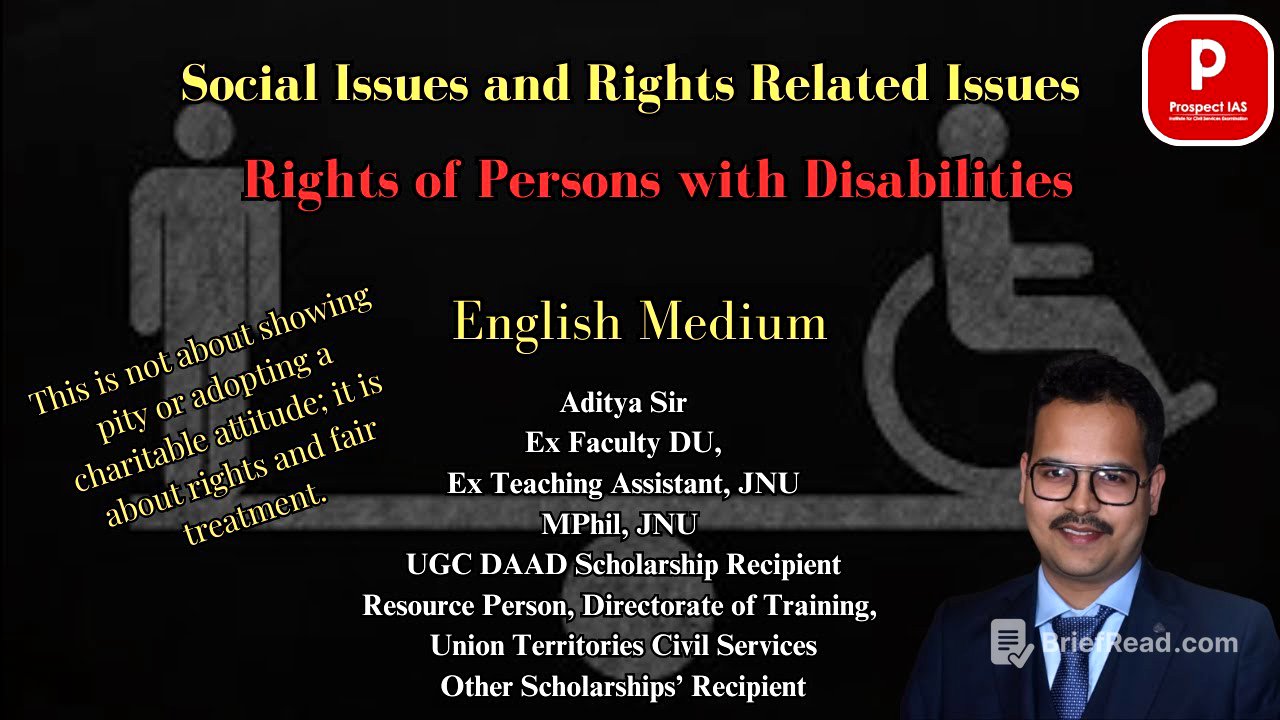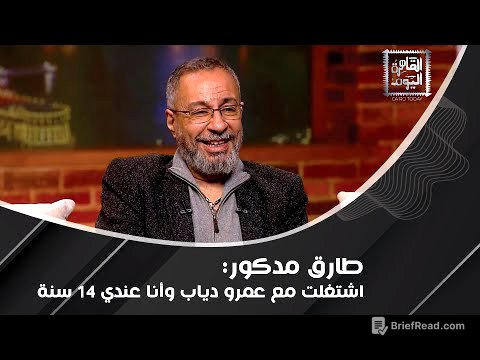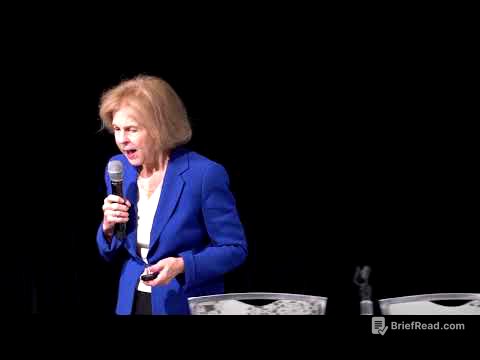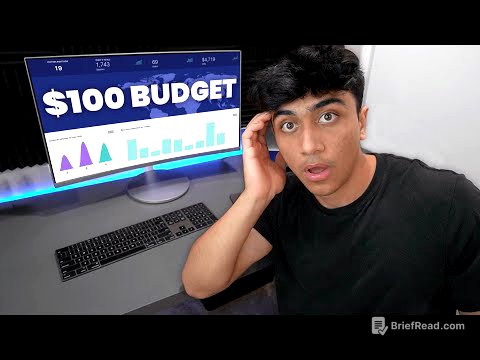TLDR;
This lecture by Prospect IAS provides a comprehensive overview of the rights of persons with disabilities, focusing on the distinction between handicap and disability, international conventions, Indian laws, and the social construction of disability. It highlights the importance of understanding disability not just as a medical issue but as a human rights issue, and the need to create an inclusive society.
- Understanding the difference between handicap, impairment, and disability.
- Examining international conventions and Indian laws related to disability rights.
- Analysing the social construction of disability and the need for an inclusive society.
Introduction [0:00]
The lecture begins with a review of previous answer submissions, focusing on sentence formation and avoiding repetition between the introduction and conclusion. The instructor suggests adding more points in the way forward, such as budgetary allocation, corruption prevention, effective policy implementation, and time-bound studies. The session then transitions to the main topic: the rights of persons with disabilities, highlighting its relevance for the UPSC examination.
Distinguishing Handicap, Impairment and Disability [6:47]
The lecture emphasises the importance of distinguishing between "handicap", "impairment", and "disability". "Handicap" is considered a derogatory term, rooted in the medieval notion of begging, while "disability" is more about social factors than physical ailments. The instructor uses the example of a person unable to cross a river without a boat to illustrate how someone can be handicapped due to external circumstances, even if physically abled. The point is made that disability is more of a social construct than a natural one.
Definitions of Disability: NHRC and WHO [13:51]
The lecture examines how different organisations define disability. The National Human Rights Commission (NHRC) defines disability as a malfunctioning, disturbance, or loss in normal physical, mental, or psychological functioning, which acts as a hurdle in equal participation in the community. The World Health Organization (WHO), in 1976, defined disability using three concepts: impairment (abnormality), disability (reduction in performance), and handicap (disadvantage). However, the WHO's definition is criticised for being too focused on medical terminologies and not recognising social factors.
Human Rights and Disability [23:51]
The discussion shifts to understanding disability as a human rights issue rather than a medical one. Human rights are defined as rights available to every human being by virtue of being human. The evolution from natural rights (life, liberty, possession) to human rights is discussed, highlighting the Universal Declaration of Human Rights by the United Nations after World War II. The lecture also mentions that both Fundamental Rights and Directive Principles of State Policy (DPSP) in the Indian Constitution contain rights that align with the Universal Declaration of Human Rights.
Indian Law and Disability [28:37]
The lecture refers to the Persons with Disability Act of 1995, which defines disability through medical lenses, including blindness, leprosy cured, hearing impairment, locomotive impairment, mental retardation, and mental illness. The United Nations Convention on Person with Disability (CRPD) incorporates both the medical outlook and rights-based approach. A practice question is given, asking how international institutions and national law have defined disability.
Disability as a Social Construct [40:12]
The lecture explores the concept of disability as a social construct, arguing that the problem is not the disabled person but the disabling world. Examples are given, such as the lack of lifts in buildings and inaccessible public transport, which prevent disabled people from participating fully in society. The evolution of Delhi Transport Corporation (DTC) buses and bus stands is used to illustrate how changes in infrastructure can make a significant difference. The point is made that to provide social justice, the disabling world needs to change.
Constitutional Rights and Disability [53:50]
The lecture examines the rights of the disabled within the Indian Constitution. While there is no specific article addressing disability, Article 15, which prohibits discrimination, includes the word "disability". The instructor notes that the Constitution is a living document that evolves over time. The UN convention maintains certain rights for disabled people, including equality in socioeconomic and cultural rights. The importance of disabled people participating in cultural events and having equal opportunities in work and education is emphasised.
UN Convention on Disability [1:10:38]
The lecture discusses the UN Convention on the Rights of Persons with Disabilities, which India signed in 2007 and became operational in 2008. The primary objective of the convention is to promote the full and equal enjoyment of all human rights and fundamental freedoms by persons with disabilities. The convention also aims to protect and ensure these rights by establishing an administrative regime. Key definitions within the convention, such as communication, language, discrimination, and universal design, are explained.
General Principles of the UN Convention [1:22:43]
The lecture highlights the general principles governing the UN Convention, as outlined in Article 3. These principles include respect for inherent dignity, individual autonomy, non-discrimination, full and effective participation and inclusion in society, respect for differences, equality of opportunity, equal access, equality between men and women, and respect for the evolving capacities of children with disabilities. The point is made that the law in India is based on these general principles.
Disability in India: Census 2011 [1:36:55]
The lecture transitions to the Indian context, using data from the Census 2011 to understand the scope of the problem. The census defined disability in eight ways: vision, hearing, speech, locomotion, mental retardation, mental illness, other, and multiple disabilities. Key findings from the census are discussed, including that 2.21% of India's population is disabled, with a higher percentage in rural areas. The lecture also notes an increase in the number of disabled persons between 2001 and 2011.
Data Analysis and Implications [1:52:25]
The lecture analyses the census data, highlighting that the highest number of disabled individuals are between 10 and 19 years old. The data also reveals that many disabled individuals are not able to pursue education and are engaged in non-work activities. The lecture identifies Uttar Pradesh, Maharashtra, and Bihar as states with the highest ratio of disabled persons. The instructor emphasises the importance of understanding these trends to frame effective policies.
The Rights of Persons with Disabilities Act 2016 [2:01:42]
The lecture discusses the Rights of Persons with Disabilities Act 2016, which was passed in line with the UN Convention. The act widens the scope of disability, adding almost 21 kinds of disabilities to the list. The act includes provisions for additional benefits for persons with benchmark disabilities, free education, reservation of seats, accessible buildings, guardianship, grievance redressal agencies, creation of funds, and penalties for violation of the law.
Government Initiatives and Future Steps [2:19:25]
The lecture mentions various government programs and initiatives, such as the Raashtria Yoja, schemes for implementation of disabilities act, Mental Health Care Act, Rehabilitation Council of India Act, and Accessible India Campaign. The instructor concludes by outlining what needs to be done, including effective implementation of laws, proper allocation of funds, strict punishment for corruption, more skill enhancement programs, proper following of universal design, regular data collection, and better health care programs. The lecture ends with homework assignments for the students.








